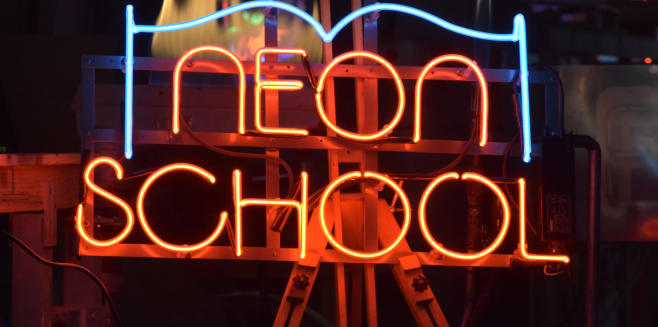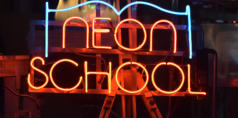
Yes there is mercury used in cold cathode (neon signs) just like the compact fluorescent
bulbs & fluorescent tubes, just to name a few. Neon tubes that have argon gas as the
light source where mercury is ionised creating a reaction to emit u/v light but due to the
fact that an argon tube operates at a low ambient temperture, most of the mercury that is
placed inside the tube remains in its liquid form for the life of the tube. The release of any
mercury from an argon tube if it is broken is very minute & would not cause mercury
poisioning it would take a constant & long time exposure to the breaking of argon tubes to
possibily have any health affects.
Please note that I have referred to argon tubes & not neon tubes, a neon tube does not
have mercury in them if you did put mercury in with neon gas the neon would become
what is called blue gas, as the mercury makes the neon to turn
blue just like an argon tube. Attached are several links to the use of mercury & the risks
of mercury poisioning with all 3 forms of the element. The mercury used in Aron tubes is
the Elemental form
The Physics of a neon light.
A neon light is defined by the use of a noble/inert gas to create light. The name of
neon was the gas use in the 1st neon signs made in 1910 in Paris. In reality these
lights of any of the nobles gases, Helium He2, Neon Ne10, Argon Ar18, Krypton Kr
36 & Xenon Xe 54. Are low pressure Discharge Tubes with the atomspheric being
between approximately of 2% for 8mm diameter glass to 1% for 15mm diameter
glass.
Light is created by ionising the gas by an electric source which excites the atoms
making them move when the collide with another atmos light is produced. The
gases being inert can not burn. These gases are Atmospheric & we see them in
nature when electrical or a magnetic force excites the gases, being known as the
Aurora Borelis (Northern Lights) and the Aurora Australis. Light from a lighting bolt
is also such an effect.
If the unfortunate event of a neon light breaking, the gas & other materials like the
mercury & phosphor powder is rushed to the ends of the tube as the atmosphere
fills the void of the vacuum inside the tube.
Yes there is mercury used in cold cathode
(neon signs) just like the compact fluorescent
bulbs & fluorescent tubes, just to name a few.
Neon tubes that have argon gas as the light
source where mercury is ionised creating a
reaction to emit u/v light but due to the fact
that an argon tube operates at a low ambient
temperture, most of the mercury that is placed
inside the tube remains in its liquid form for
the life of the tube. The release of any mercury
from an argon tube if it is broken is very minute
& would not cause mercury poisioning it would
take a constant & long time exposure to the
breaking of argon tubes to possibily have any
health affects.
Please note that I have referred to argon tubes
& not neon tubes, a neon tube does not have
mercury in them if you did put mercury in with
neon gas the neon would become what is called
blue gas, as the mercury makes the neon to turn
blue just like an argon tube. Attached are several
links to the use of mercury & the risks of mercury
poisioning with all forms of the element.The
mercury used in Aron tubes is the Elemental form

The Physics of a neon light.
A neon light is defined by the use of a
noble/inert gas to create light. The name of neon
was the gas use in the 1st neon signs made in
1910 in Paris. In reality these lights of any of the
nobles gases, Helium He2, Neon Ne10, Argon
Ar18, Krypton Kr 36 & Xenon Xe 54. Are low
pressure Discharge Tubes with the atomspheric
being between approximately of 2% for 8mm
diameter glass to 1% for 15mm diameter glass.
Light is created by ionising the gas by an electric
source which excites the atoms making them
move when the collide with another atmos light
is produced. The gases being inert can not burn.
These gases are Atmospheric & we see them in
nature when electrical or a magnetic force
excites the gases, being known as the Aurora
Borelis (Northern Lights) and the Aurora
Australis. Light from a lighting bolt is also such
an effect.
If the unfortunate event of a neon light breaking,
the gas & other materials like the mercury &
phosphor powder is rushed to the ends of the
tube as the atmosphere fills the void of the
vacuum inside the tube.

Yes there is mercury used in cold cathode (neon signs) just like the compact fluorescent
bulbs & fluorescent tubes, just to name a few. Neon tubes that have argon gas as the
light source where mercury is ionised creating a reaction to emit u/v light but due to the
fact that an argon tube operates at a low ambient temperture, most of the mercury that is
placed inside the tube remains in its liquid form for the life of the tube. The release of any
mercury from an argon tube if it is broken is very minute & would not cause mercury
poisioning it would take a constant & long time exposure to the breaking of argon tubes to
possibily have any health affects.
Please note that I have referred to argon tubes & not neon tubes, a neon tube does not
have mercury in them if you did put mercury in with neon gas the neon would become
what is called blue gas, as the mercury makes the neon to turn
blue just like an argon tube. Attached are several links to the use of mercury & the risks
of mercury poisioning with all 3 forms of the element. The mercury used in Aron tubes is
the Elemental form
The Physics of a neon light.
A neon light is defined by the use of a noble/inert gas to create light. The name of
neon was the gas use in the 1st neon signs made in 1910 in Paris. In reality these
lights of any of the nobles gases, Helium He2, Neon Ne10, Argon Ar18, Krypton Kr
36 & Xenon Xe 54. Are low pressure Discharge Tubes with the atomspheric being
between approximately of 2% for 8mm diameter glass to 1% for 15mm diameter
glass.
Light is created by ionising the gas by an electric source which excites the atoms
making them move when the collide with another atmos light is produced. The
gases being inert can not burn. These gases are Atmospheric & we see them in
nature when electrical or a magnetic force excites the gases, being known as the
Aurora Borelis (Northern Lights) and the Aurora Australis. Light from a lighting bolt
is also such an effect.
If the unfortunate event of a neon light breaking, the gas & other materials like the
mercury & phosphor powder is rushed to the ends of the tube as the atmosphere
fills the void of the vacuum inside the tube.